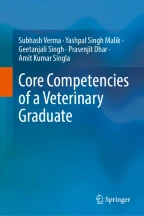Comprehensive Knowledge of Non-infectious Diseases of Livestock Including Pets, Birds, and Wildlife

This chapter’s objective is to underscore that livestock, pets, and poultry are susceptible to a spectrum of disorders that do not stem directly from microbial involvement. These diseases can impact diverse bodily systems, including the respiratory, reproductive, digestive, musculoskeletal, cardiovascular, nervous, and endocrine systems. Many of these disorders have a metabolic basis, characterized by disruptions in the animal’s metabolic processes, often tied to imbalances in energy or nutrients. Several of these conditions become apparent during the peri-parturient period or early lactation in dairy animals, and some can be attributed to changes in diet and management practices. Others may be associated with factors like genetics, nutrition, or stress. The primary aim is to draw attention to these significant non-infectious diseases. The incidence of these conditions can vary depending on factors such as management practices, species type, breed, physiological status, age, and gender. It is of utmost importance for veterinarians to possess a thorough understanding of these conditions to be able to accurately diagnose, treat, prevent, and manage them effectively.
This is a preview of subscription content, log in via an institution to check access.
Access this chapter
Subscribe and save
Springer+ Basic
€32.70 /Month
- Get 10 units per month
- Download Article/Chapter or eBook
- 1 Unit = 1 Article or 1 Chapter
- Cancel anytime
Buy Now
Price includes VAT (France)
eBook EUR 149.79 Price includes VAT (France)
Hardcover Book EUR 189.89 Price includes VAT (France)
Tax calculation will be finalised at checkout
Purchases are for personal use only
Further Reading
- Gupta RK Metabolic diseases in farm animals Google Scholar
- Nelson RW, Couto CG Small animal internal medicine Google Scholar
- NJ Merck & co., Inc The merck veterinary manual, whitehouse station Google Scholar
- Penner GB Instant insights: metabolic disorders in dairy cattle Google Scholar
- Pugh DG, Baird AN Sheep and goat medicine Google Scholar
- Radostits OM, Gay CC, Hinchcliff KW, Constable PD Veterinary medicine Google Scholar
- Smith MC Goat medicine Google Scholar
- Smith BP, Van Metre DC Large animal internal medicine Google Scholar
- Withrow SJ, Vail DM Withrow and MacEwen’s small animal clinical oncology Google Scholar
Author information
Authors and Affiliations
- Department of Veterinary Microbiology, Ch. Sarwan Kumar Himachal Pradesh Agricultural University, Palampur, Himachal Pradesh, India Subhash Verma & Prasenjit Dhar
- College of Animal Biotechnology, Guru Angad Dev Veterinary and Animal Sciences University, Ludhiana, Punjab, India Yashpal Singh Malik
- Department of Veterinary Physiology & Biochemistry, Ch. Sarwan Kumar Himachal Pradesh Agricultural University, Palampur, Himachal Pradesh, India Geetanjali Singh
- Department of Veterinary Surgery & Radiology, Ch. Sarwan Kumar Himachal Pradesh Agricultural University, Palanpur, Himachal Pradesh, India Amit Kumar Singla
- Subhash Verma

